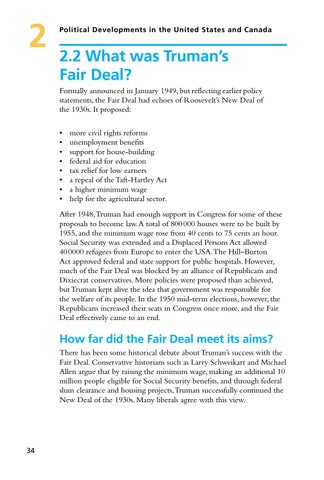2
Political Developments in the United States and Canada
2.2 What was Truman’s Fair Deal? Formally announced in January 1949, but reflecting earlier policy statements, the Fair Deal had echoes of Roosevelt’s New Deal of the 1930s. It proposed: • • • • • • • •
more civil rights reforms unemployment benefits support for house-building federal aid for education tax relief for low earners a repeal of the Taft-Hartley Act a higher minimum wage help for the agricultural sector.
After 1948, Truman had enough support in Congress for some of these proposals to become law. A total of 800 000 houses were to be built by 1955, and the minimum wage rose from 40 cents to 75 cents an hour. Social Security was extended and a Displaced Persons Act allowed 40 0000 refugees from Europe to enter the USA. The Hill–Burton Act approved federal and state support for public hospitals. However, much of the Fair Deal was blocked by an alliance of Republicans and Dixiecrat conservatives. More policies were proposed than achieved, but Truman kept alive the idea that government was responsible for the welfare of its people. In the 1950 mid-term elections, however, the Republicans increased their seats in Congress once more, and the Fair Deal effectively came to an end.
How far did the Fair Deal meet its aims? There has been some historical debate about Truman’s success with the Fair Deal. Conservative historians such as Larry Schweikart and Michael Allen argue that by raising the minimum wage, making an additional 10 million people eligible for Social Security benefits, and through federal slum clearance and housing projects, Truman successfully continued the New Deal of the 1930s. Many liberals agree with this view.
34
